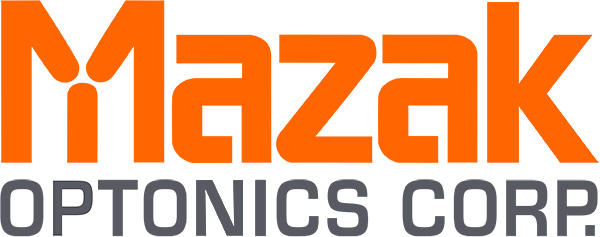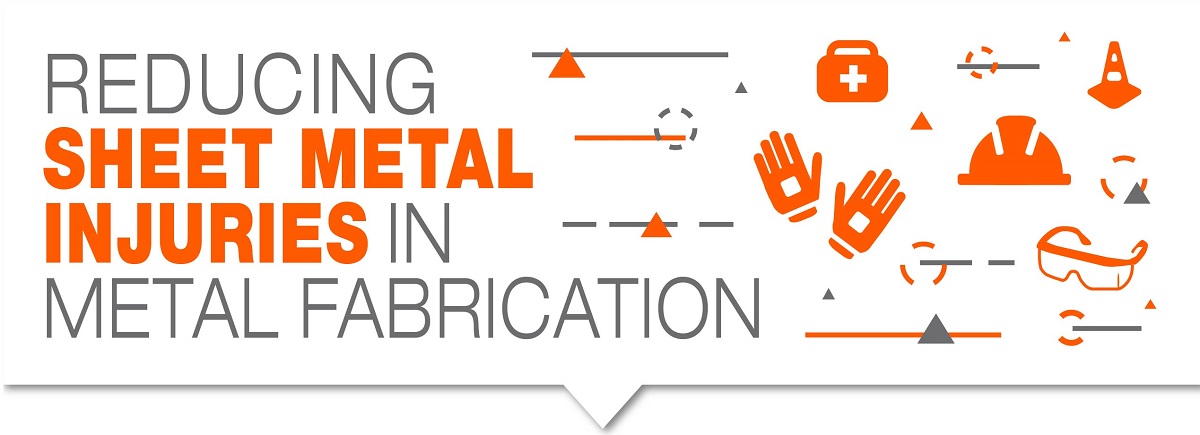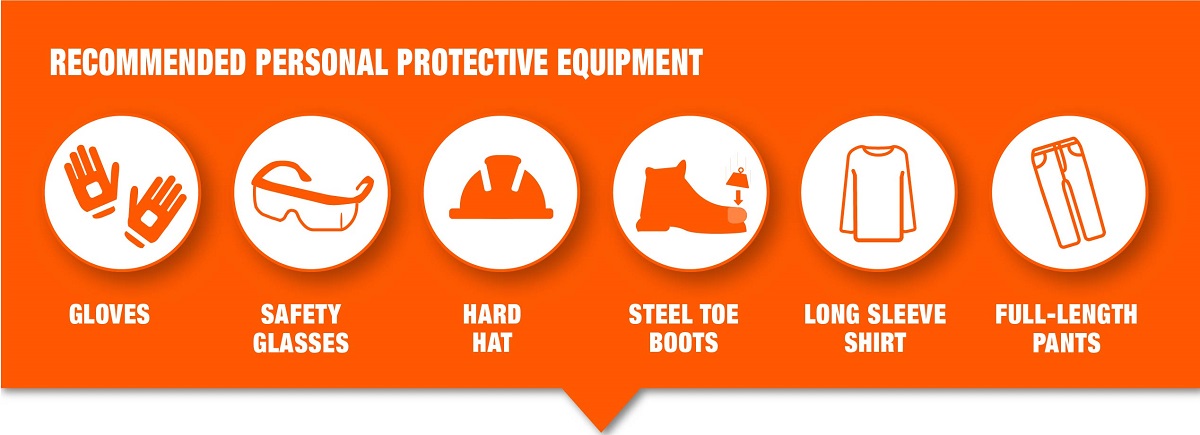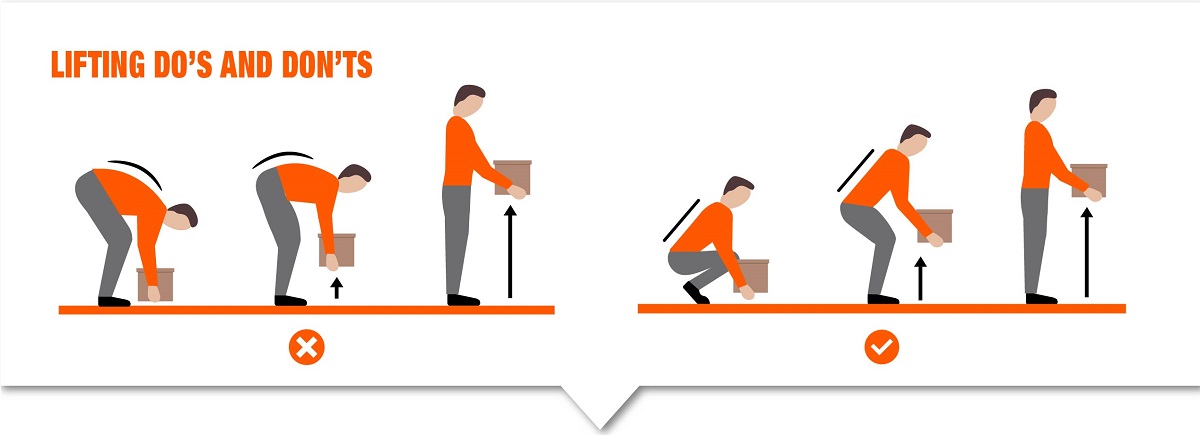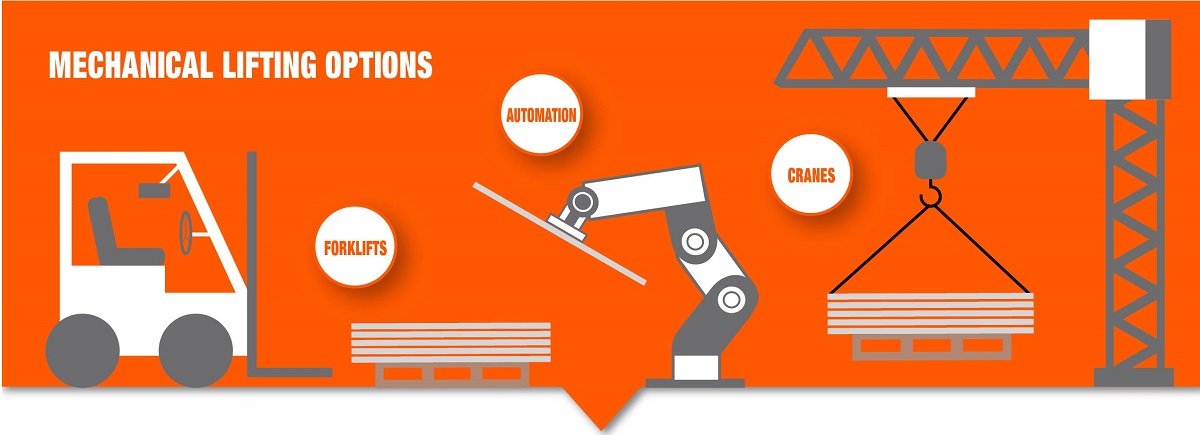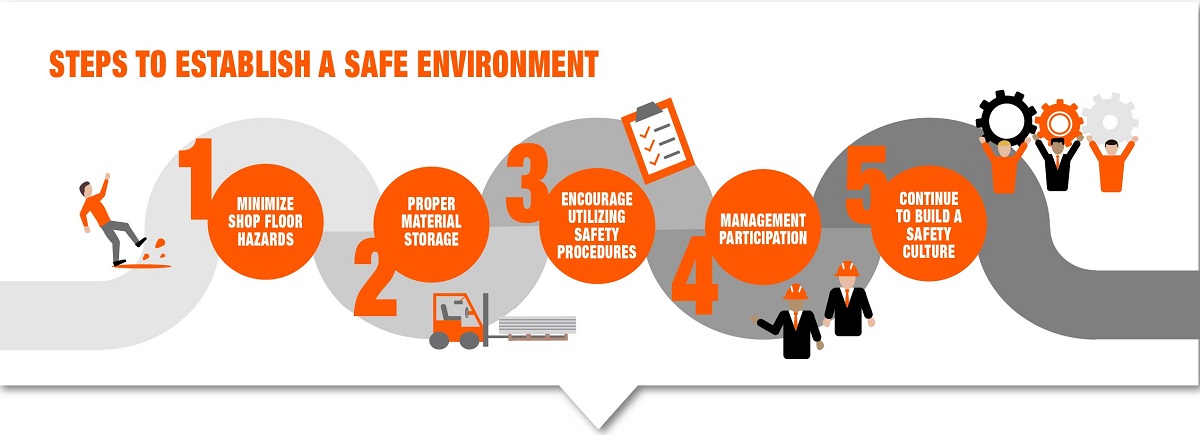Minimize your risk of injury by utilizing these safety procedures for working with sheet metal
By Brian Ekman, Safety Consultant at East Coast Risk Management, LLC and Megan Tsevelekos, Marketing Specialist at Mazak Optonics Corp.
It is no surprise that working in the metal fabrication industry can be dangerous at times. With sharp edges and varying weight, sheet metal increases the potential risk for an injury to occur. In 2018, the rate of nonfatal occupational injuries for the metal fabrication industry was 4.1 recordable cases per 100 employees. Recordable cases are injuries that need treatment beyond a First Aid kit. When working with sheet metal, it is crucial to understand the risks and safety procedures to minimize your risk of incurring an injury.
Adopting safety practices not only protects your employees, it can affect your bottom-line. The average total cost of a recordable injury in metal fabrication is over $80,000. Direct costs and indirect costs both factor into the total expense of having an injured employee.
Direct costs are more straightforward to calculate. These include payments of medical bills and workman’s compensation. However, the real harm comes from intangible indirect costs.
Indirect costs can include factors such as lost time, cost of training a new employee, loss of production, and a decrease in employee morale. In order to offset expenses incurred from an injury, additional revenue would need to be generated. This typically averages over $2 million. Ouch. Altogether, an injury could be more painful to your business than the physical harm endured by the employee.
While injuries and accidents happen, it is important to take steps to prevent harm to employees and your fabrication business. By wearing the required personal protective equipment, following proper material handling procedures and keeping an orderly shop, you can minimize potential risks to your business. But first, let’s discover what injuries are common when working in metal fabrication.
Susceptible injuries
You may have heard incidents of on-the-job injuries or maybe you learned the hard way. The possibility for injuries is always present, even when being careful. However, understanding what sheet metal injuries fabricators are vulnerable to can help increase awareness and prevent future incidents from occurring. Some of the most common recordable injuries caused by sheet metal include lacerations and punctures, strains and sprains, and on occasion burns.
Starting with cuts and punctures, these are typically caused by exposure to sharp edges and corners of sheet metal. Strains and sprains are commonly caused by improper lifting tactics or repetitive movements.
As a result of not utilizing ergonomic lifting procedures, workers are at risk for potential injuries. These risks include tearing muscles and ligaments, developing poor posture and, one of the most chronic injuries from poor lifting, lower-back pain.
Burns are also a potential concern when working in metal fabrication. For instance, a burn can occur when grabbing parts without gloves too quickly after a heat-related process, such as laser-cutting or welding.
While these injuries seem minor, the possibility for more serious incidents can become a cause for concern if the proper mandates are not taken. It is important to always be aware of your surroundings and to use caution when working around heavy machinery.
No need to panic, these injuries are preventable and can be minimized through wearing personal protective equipment, following proper material handling procedures, and by keeping an orderly shop.
Gearing up
Having Personal Protective Equipment (PPE) on and wearing proper clothing helps protect you against sheet metal injuries. While the required PPE varies for different metal fabrication processes, the recommended PPE items for the industry include: gloves, safety glasses, hard hat when working with overhead hazards, steel toe shoes, long sleeve shirts, and full-length pants.
Gloves are a must-have when handling sheet metal. While there are several different options for gloves, you want to have heavy-duty grade gloves with cut resistance. Some gloves offer back-of-hand protection as well, which can help save your hand from impact when laying material down. Gloves that also offer heat protection are great for picking up parts after a heat-related fabrication process.
Another PPE item that can save you from getting cut up are cut resistance sleeves. These are essentially gloves for your arms and can help minimize scrapes from carrying metal. While cut resistance sleeve are helpful, they are optional.
In some metal fabrication operations, your eyes can be exposed to flying debris. Foreign objects, such as a metal chip or particle, can come in contact with your eyes. Therefore, wearing safety glasses during these processes is critical. Some operations even call for a full-face shield, such as grinding or welding A face shield will not only protect your eyes, but your whole face from any flying debris.
While ball caps are more stylish, hard hats are required to be worn when overhead hazards are present in your facility. These hazards can include overhead cranes and other rigging mechanisms. Hard hats should also be worn when stacking material vertically. Falling objects are possible during material handling operations and a hard hat will protect you from impact.
While fashion might not be a top priority in the metal fabrication industry, wearing the proper clothing will help minimize the potential for injuries. Clothes that should never be worn while working with moving machinery include loose-fitting clothes and jewelry. Even if you are being cautious while wearing these items, they can get caught on parts of the machine or snag on a piece of sheet metal and result in an injury.
Clothing items that metal fabricators are encouraged to wear are steel-toe boots, long-sleeve shirts, and full-length pants. Steel-toe boots will protect your toes if an accident were to occur, such as falling material or simply walking around sheet metal. Wearing fitted long-sleeve shirts and full-length pants are also recommended to help minimize the risk of receiving an injury. The less exposed your skin is, the less susceptible you are to sheet metal injuries.
Let’s face it, PPE isn’t necessarily the latest fashion trend. However, making the effort to properly equip yourself will protect you in the long run. PPE is the last line of defense to save you from a possible injury.
Material handling best practices
One of the best ways to reduce sheet metal injuries in the workplace is by following proper material handling procedures. Sheet metal comes in various weights and lengths. Different sizes and weights of material can call for different material handling measures. Thin sheet metal can be flimsy, making it awkward to carry and can lead to tripping or causing you to lose your balance. While thicker material typically leads to increased weight, these heavier materials require a helping hand by a coworker or using machinery.
There are three forms of lifts that should be incorporated in your material handling practices. These lifts are manual lifts, team lifts, and mechanical lifts. Before ever attempting to lift any material, determine which lifting tactic is suitable for the material and makes sense for your shop operations.
Manual lift
Before attempting a manual lift, also known as moving material by yourself, determine whether the load is safe to carry solo. When carrying material on your own, it is recommended to wear gloves, steel-toe boots, full-length pants, and a long-sleeve shirt to protect yourself. When performing a manual lift, it is essential to utilize ergonomic lifting tactics will save your body from aches and pains.
Ergonomics is the applied science for designing safe movements of the human body for efficiency. Ergonomics is highly encouraged when working in environments that required constant material handling or repetitive movements.
Follow these ergonomic lifting tactics to minimize aches and pains:
- Lifting with your legs rather than bending over with your back
- Keeping your back aligned while lifting
- Arms should be bent, not extended
- Carry material close to your core
- Pivot feet to avoid twisting
There are also other handy tools to use when handling sheet metal by yourself. Industrial magnets and suction cups are great resources for picking up parts or material. Using these tools reduces the risk of getting cut by sharp edges.
Another way to reduce muscle strains in manual lifts is by taking multiple trips of smaller material loads rather than one large load. Utilizing buckets for loose pieces of metal is another great way to minimize cuts and dropping material when walking.
Lastly, use a cart for transporting materials can be helpful for moving full sheets of metal and larger loads by yourself in a shop.
Team lift
When you cannot lift material by yourself, ask for a helping hand. Even if you think you might be able to lift something on your own, it is better to have assistance than risking an injury.
One of the most important factors of performing a team lift is proper communication. Communication is key when picking up a piece of heavy sheet metal. Make sure to count off before picking up material as well as when lowering material so weight is evenly distributed. Communicate any changes in direction or potential hazards that may appear during the lift.
Another way to increase safety when performing a team lift is to not have anyone walking backwards. Instead, hold material on each side and walk parallel in the direction you are moving the material towards. This helps ensure that everyone involved can see where they are going and if any potential hazards are present while moving.
Make sure to always use ergonomic lifting tactics during a team lift as well. Depending on the size of the load, you may need additional assistance through mechanical lifting solutions.
Mechanical lift
There are several options for using machinery to assist with material handling. The three most common mechanical lifts for the metal fabrication industry are forklifts, rigging mechanisms, and lastly automation solutions.
Forklifts are great for transferring pallets of sheet metal around your shop as well as stacking materials. However, in order to operate a forklift, drivers must be certified. During certification training, drivers are taught the proper requirements for safely operating the machine. Operators must get recertified every three years.
Overhead cranes and rigging mechanisms are another helpful tool to use for moving large loads. When using rigging mechanisms, slings are typically used to harness the material. Slings should be inspected regularly for damage because the sharp edges of sheet metal or pallets can cause cuts on the slings, which could lead to malfunctions. Remember to put your hard hat on when using any type of rigging or overhead equipment.
One of the most helpful and productive solutions for mechanically lifting material is through automation. Adding an automation system to your shop will not only help with lifting materials off your machine, but they increase productivity and efficiencies in your operations.
For example, laser automation systems reduce the burden of adding manpower to your shop as well as minimize the physical strain on employees. A recent advancement in automation solutions is part sorting. This type of system eliminates repetition in movements picking up processed parts directly from the laser machine’s pallet and places them on pallets. Investing in automation solutions increases safety in your shop and extends throughput capacity of operations.
Incorporating these material handling practices will help keep your workforce safe and improve material flow around your shop.
Establishing a safe environment
While practicing safety procedures can minimize vulnerability to sheet metal injuries, they won’t always be effective if the environment isn’t safe to begin with. In order to establish a safe working environment, aim to minimize tripping hazards and build a safety culture within your business.
Keeping your shop free of clutter has more benefits than just staying organized. Unorganized material in a shop creates potential tripping hazards for workers. Not to mention, material that isn’t organized is inefficient for business operations. Scattered pallets of sheet metal, tools laying out, and other debris around your shop can easily cause workers to trip.
Along with this, it’s crucial to keep pathways and fire exits clear of debris at all times. This allows for a quick evacuation and minimizes the risk of tripping when trying to exit during an emergency.
Another floor hazard to be aware of is spills. If a spill occurs on the shop floor, clean it up immediately to avoid causing anyone to slip and fall. Losing your balance, especially when carrying materials, can be a recipe for getting injured.
Keeping material properly stored in your workspace is great for efficient operations, as well as keeping workers safe. However, use caution when stacking materials. Material that is stacked too high or unevenly could fall over. Falling material can potentially strike a worker, not to mention causing a big mess in your shop.
When disorderly, shops can be filled with accidents waiting to happen. While most people might not enjoy cleaning up and putting things away, good housekeeping practices minimizes the potential of hazards for your employees.
One of the most important aspects of creating a safe environment is by building a safety culture among all employees. Adopting and encouraging safety practices for your business will help reduce sheet metal injuries as well as keeping workers motivated to follow procedures.
The key aspect to building a successful safety culture is by having management participate. If management doesn’t follow the required PPE needed to be worn when on the shop floor or follow enforced safety procedures, workers will not follow. A safety culture can only emerge when all employees are engaged.
When implementing safety protocols, employees must be trained and encouraged to utilize these procedures to maintain shop safety. Newly hired employees should also receive proper training regarding company safety procedures. However, current employees need to be reminded of safety procedures. A great tactic for this is having toolbox talks and periodic trainings to reinforce safety procedures and potential hazards workers are exposed to on a daily basis.
Adopting safety procedures and creating a safe environment in your workplace not only minimizes your risk for sheet metal injuries, it also boosts employee morale by having a healthy workforce.
Following safety procedures is important for the well-being of your employees and fabrication business. By taking these actions, you can work towards preventing injuries among your employees and avoid associated costs for your business.
For more information regarding safety regulations and procedures, refer to these sources:
- Occupational Safety and Health Administration (OSHA)
- The National Institute for Occupational Safety and Health (NIOSH)
- American National Standards Institute (ANSI)
- East Coast Risk Management - Safety Consulting Services
